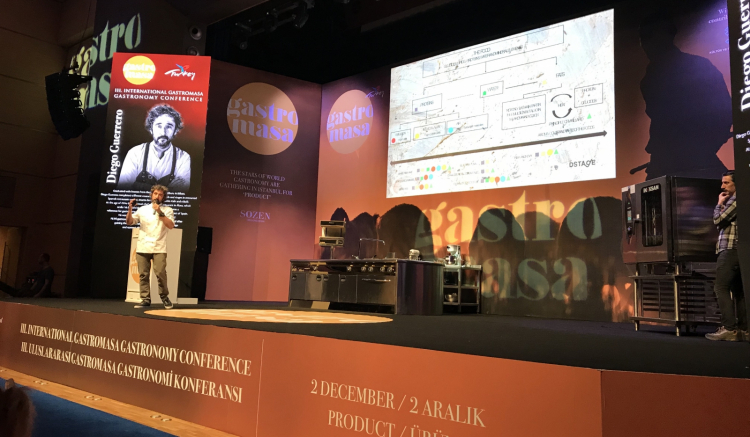Some become chefs by chance, some because of family traditions, some because that’s all they can do, and some out of natural passion. Diego Guerrero, now working in Madrid, but born in Vitoria, País Vasco, in 1975, became a chef because he’s a rebel: «I didn’t think I would take this career. Or rather, I had, and still have, many interests: music, art, communication… When I turned 18 I didn’t have a clear idea, so I listed my options: first, I wanted to become a journalist, then a painter. Chef was one of the possible choices, the third and last one: after all, it was a way of expressing myself. So I spoke with my parents and they said: “Choose what you wish, but don’t become a chef". Of course, that’s what I chose».
Guerrero is one of the most important people in the Spanish avantgarde, even though others are more popular than him in Italy: his
DSTAgE, opened on July 1st 2014 in Las Salesas, in Madrid, conquered its second star in the 2017 Michelin Guide. It’s a successful project (a few months ago, he calculated he has served 29000 clients, based on 65959 online reservations), where
Guerrero arrived as patron chef after training in places such as
Martín Berasategui in Lasarte and
Goizeko Kabi in Bilbao and Madrid; he’s been working in the capital for 15 now, and has already received two stars at
El Club Allard, which he left in October 2013.
«I was lucky – he says – because in my life I had the chance to meet my idols and speak, think, interact with them. With
Ferran Adrià above all. They’re not just chefs: they’re inspiring people, they convey a vision». We met him in Istanbul, on the third edition of
Gastromasa, the international culinary congress created by
Gökmen Sözen.

Guerrero on the stage of Gastromasa, in Istanbul
They asked him to speak of “products”, and he told us: «I wondered if it made sense to speak of Spanish ingredients in Turkey: or was I to act as an expert of some Turkish ingredient? Of course, I couldn’t. So I tried to think of a common language in the kitchen. Food? Technique? The answer: it all boils down to the same bricks, which are in fact proteins, fat, water. They are the same pieces that shape food, and give it texture and flavour. Think of collagen [a protein] which preserves the flavour of an ingredient. Fat is also an excellent vessel for aromas. Or a process like Maillard’s reaction, an interaction of sugars and proteins during cooking».
So, if you speak of these things, you go to the basics, to the essential and universal foundations, and you go beyond a territory. If you’re Spanish and get on a stage in Turkey but everyone will still feel involved. So he presented a flan made with octopus (that is to say: octopus proteins, made from a broth in which he melts collagen, which replace eggs in terms of flavour), later enriched with the essence of Carabineros prawns and air made again with octopus collagen; or a real-fake sardine, in which the body is made by warming up some tapioca in a broth made with jamón and kombu seaweed.
Collagen extraction was the focus, but there’s more: «The other bricks on which you can build your food are personal experiences, passions, memories, your ideas, actions, mistakes and challenges».
Guerrero built
DSTAgE on this, a 300 square metre place spread over two floors. On the top one, clients start their culinary experience with snacks from the bar at the entrance, before moving to the kitchen and dining room, around a patio which can seat up to 40 clients. At the back of the restaurant, and visible from almost every corner, we have the stoves. From there, cooks arrive and blend with the dining room team and serve the guests. In September 2016 the chef also created a creative space,
DSPOT, 370 square metres focused on fine dining creativity in all its facets, like scenes, design, techniques and products.
DSTAgE is a restaurant with a contemporary concept, no frills, casual style, informal and innovative: «It allows me to have a gastronomy with few frills, in which I’m closer to the client. It’s the dimension in which I feel more at ease». Here he developed dishes that are now modern classics:
Cannelloni with coconut and prawns, Sequence of pandan (it’s a plant that has very aromatic leaves, largely used in South East Asia),
Crispy pork sandwich, "Beef heart " and raspberry, Tuna, toffee and “foiesabi”, Cauliflower chantilly.
Translated into English by Slawka G. Scarso